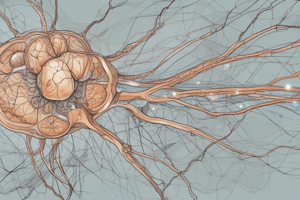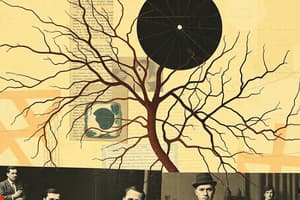Podcast
Questions and Answers
What are the two main tracts of the pyramidal tract?
What are the two main tracts of the pyramidal tract?
- Tectospinal tract and Rubrospinal tract
- Medial longitudinal fasciculus and Anterior vestibulospinal tract
- Lateral vestibulospinal tract and Reticulospinal tract
- Anterior corticospinal tract and Lateral corticospinal tract (correct)
What is the primary function of the primary motor cortex?
What is the primary function of the primary motor cortex?
Movement execution
What is the primary function of the premotor cortex?
What is the primary function of the premotor cortex?
Planning and selecting movements
The reticular formation is involved in the control of voluntary movements.
The reticular formation is involved in the control of voluntary movements.
The vestibular nuclei are involved in the control of eye movements.
The vestibular nuclei are involved in the control of eye movements.
The primary motor cortex is responsible for the selection of movements.
The primary motor cortex is responsible for the selection of movements.
The lateral premotor cortex is involved in the selection of movements based on external events.
The lateral premotor cortex is involved in the selection of movements based on external events.
The medial premotor cortex is involved in the selection of movements based on internal events.
The medial premotor cortex is involved in the selection of movements based on internal events.
What is the function of the rubrospinal tract?
What is the function of the rubrospinal tract?
The rubrospinal tract is ipsilateral in nature. (i.e. it affects the same side of the body as the lesion)
The rubrospinal tract is ipsilateral in nature. (i.e. it affects the same side of the body as the lesion)
The vestibulospinal tract is responsible for maintaining balance during acceleration.
The vestibulospinal tract is responsible for maintaining balance during acceleration.
Damage to the descending motor pathways in the internal capsule can cause an immediate flaccidity of the muscles on the contralateral side of the body and face.
Damage to the descending motor pathways in the internal capsule can cause an immediate flaccidity of the muscles on the contralateral side of the body and face.
The Babinski sign is a normal response in an adult to stroking the sole of the foot.
The Babinski sign is a normal response in an adult to stroking the sole of the foot.
Spasticity is an increased muscle tone.
Spasticity is an increased muscle tone.
Rigidity is a sign of upper motor neuron damage.
Rigidity is a sign of upper motor neuron damage.
Clonus is a rhythmic, involuntary muscle contraction.
Clonus is a rhythmic, involuntary muscle contraction.
A loss of the ability to perform fine movements is a sign of upper motor neuron damage.
A loss of the ability to perform fine movements is a sign of upper motor neuron damage.
Match the following descending tracts with their corresponding functions:
Match the following descending tracts with their corresponding functions:
Flashcards
Vestibular Nuclei
Vestibular Nuclei
A group of nuclei in the brainstem that are involved in maintaining posture and balance. They receive input from the inner ear and project to the spinal cord.
Medial Vestibulospinal Tract
Medial Vestibulospinal Tract
A descending pathway from the vestibular nuclei that controls axial muscles, responsible for posture.
Lateral Vestibulospinal Tract
Lateral Vestibulospinal Tract
A descending pathway from the vestibular nuclei that controls proximal limb muscles, aiding in coordination.
Reticular Formation
Reticular Formation
Signup and view all the flashcards
Feedforward Mechanism in Reticular Formation
Feedforward Mechanism in Reticular Formation
Signup and view all the flashcards
Primary Motor Cortex (Brodmann's Area 4)
Primary Motor Cortex (Brodmann's Area 4)
Signup and view all the flashcards
Betz Cells
Betz Cells
Signup and view all the flashcards
Pyramidal Tract
Pyramidal Tract
Signup and view all the flashcards
Corticobulbar Tract
Corticobulbar Tract
Signup and view all the flashcards
Corticospinal Tract
Corticospinal Tract
Signup and view all the flashcards
Decussation of the Pyramidal Tract
Decussation of the Pyramidal Tract
Signup and view all the flashcards
Ventral Corticospinal Tract
Ventral Corticospinal Tract
Signup and view all the flashcards
Indirect Pathway
Indirect Pathway
Signup and view all the flashcards
Premotor Cortex
Premotor Cortex
Signup and view all the flashcards
Lateral Premotor Cortex
Lateral Premotor Cortex
Signup and view all the flashcards
Medial Premotor Cortex
Medial Premotor Cortex
Signup and view all the flashcards
Upper Motor Neuron Syndrome
Upper Motor Neuron Syndrome
Signup and view all the flashcards
Spinal Shock
Spinal Shock
Signup and view all the flashcards
Babinski Sign
Babinski Sign
Signup and view all the flashcards
Spasticity
Spasticity
Signup and view all the flashcards
Decerebrate Rigidity
Decerebrate Rigidity
Signup and view all the flashcards
Loss of Fine Motor Control
Loss of Fine Motor Control
Signup and view all the flashcards
Lower Motor Neuron Facial Weakness
Lower Motor Neuron Facial Weakness
Signup and view all the flashcards
Upper Motor Neuron Facial Weakness
Upper Motor Neuron Facial Weakness
Signup and view all the flashcards
Cingulate Motor Area
Cingulate Motor Area
Signup and view all the flashcards
Corticobulbar Pathways
Corticobulbar Pathways
Signup and view all the flashcards
Feedforward Motor Control
Feedforward Motor Control
Signup and view all the flashcards
Feedback Motor Control
Feedback Motor Control
Signup and view all the flashcards
Corticospinal Tract
Corticospinal Tract
Signup and view all the flashcards
Extrapyramidal Tracts
Extrapyramidal Tracts
Signup and view all the flashcards
Fractionated Movements
Fractionated Movements
Signup and view all the flashcards
Study Notes
Upper Motor Neurons Maintaining Balance and Posture
- Vestibular nuclei are upper motor neurons in the brainstem.
- Projections from vestibular nuclei control axial muscles and proximal limb muscles via medial and lateral vestibulospinal tracts.
- Additional upper motor neurons in vestibular nuclei project to cranial nerve nuclei for eye movement control (III, IV, VI). This maintains fixation while the head moves.
- Direct projections from vestibular nuclei to spinal cord enable quick compensatory responses to postural instability sensed by the inner ear.
Reticular Formation as Upper Motor Neurons
- The reticular formation is a complex network in the brainstem, similar to the intermediate gray matter in the spinal cord.
- It handles various functions, including cardiovascular/respiratory control, sensory motor reflexes, eye movements, sleep-wake cycles, and coordination of movements.
- Descending motor control pathways from the reticular formation to the spinal cord are similar to those of the vestibular nuclei.
- Reticular formation motor centers are influenced by cortical or brainstem centers and initiate adjustments to maintain posture during movement. They predict potential instability and generate corrective movements.
Origin of Pyramidal Tract
- Upper motor neurons in the cerebral cortex (frontal lobe areas) plan and initiate complex voluntary movements.
- These cortical areas receive input from basal ganglia, cerebellum, and sensory regions within the parietal lobe.
- The primary motor cortex (Brodmann's area 4, precentral gyrus) contains upper motor neurons (Betz cells of layer V).
Course of Pyramidal Tract
- Pyramidal tract axons descend to brainstem/spinal motor centers within the corticobulbar and corticospinal tracts.
- They travel through the internal capsule, cerebral peduncles, pons, and form medullary pyramids in the medulla's ventral surface.
- Some axons within the corticobulbar tract innervate cranial nerve nuclei, reticular formation, and red nucleus in the brainstem.
- Most corticospinal tract axons cross over (decussate) in the medulla forming the lateral corticospinal tract.
- Some axons remain uncrossed forming the ventral corticospinal tract and terminate ipsilaterally or contralaterally.
- Ventral corticospinal tract axons primarily innervate muscles controlling axial and proximal limbs.
The Premotor Cortex
- This complex network of interconnected frontal lobe areas lies in front of the primary motor cortex.
- Upper motor neurons within the premotor cortex influence movements through connections with the primary motor cortex, and directly via corticobulbar and corticospinal pathways.
Lateral Premotor Cortex
- Involved in selecting movements based on external cues (visual or verbal commands).
- Damage to this area impacts learning movements in response to external stimuli.
Medial Premotor Cortex
- Involved in selecting movements based on internal cues.
- Damage leads to reduced spontaneous movements, despite ability to execute movements based on external cues.
Summary
- Two sets of upper motor neuron pathways control local circuitry in the brainstem and spinal cord.
- Vestibular nuclei/reticular formation contribute to postural regulation (feedforward/feedback mechanisms).
- The other major pathway originates in the frontal lobe (primarily primary motor cortex and premotor area) for movement execution and selection of movements.
- The motor cortex influences movements directly via corticospinal/corticobulbar tracts, and indirectly via brainstem centers (reticular formation/red nucleus), via reticulospinal/vestibulospinal/rubrospinal tracts..
Studying That Suits You
Use AI to generate personalized quizzes and flashcards to suit your learning preferences.
Related Documents
Description
This quiz explores the role of upper motor neurons in maintaining balance and posture, focusing on vestibular nuclei and the reticular formation. It covers how these structures interact to control muscles and reflexes necessary for stabilization. Test your understanding of the brainstem's influence on body posture and movement coordination.




